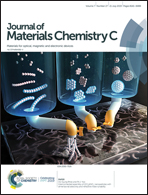Tetragonal BaTiO3 nanowires: a template-free salt-flux-assisted synthesis and its piezoelectric response based on mechanical energy harvesting†
Abstract
Intense research has been carried out towards the synthesis of one-dimensional (1D) barium titanate (BaTiO3: BT) because of its high output performance with anisotropic direction, which is expected to be applicable in piezoelectric nanogenerators for self-powered devices. This article emphasizes the essential process in producing BaTiO3: BT nanowires (NWs) in a simple and cost-effective way via a template-free salt-flux-assisted (SFA) method. The single phase of tetragonal BaTiO3 was confirmed by X-ray diffraction (XRD) with Rietveld refinement analysis and Raman spectroscopy. The spontaneous polarization of 49.7 μC cm−2 was calculated. Field-emission scanning electron microscope (FE-SEM) and transmission electron microscope (TEM) micrographs show uniform NWs with a diameter of ∼70 nm and a length of more than 2 μm. The corresponding selected-area electron diffraction (SAED) pattern displayed single-crystalline nature within tetragonal symmetry, and the lattice fringes demonstrate growth along the [111]-orientation of the 1D-BaTiO3 nanowires (BT-NWs). Furthermore, this article exhibits progress made in applying energy harvesting nanocomposite materials. The flexible nanocomposite of BT-NWs in polydimethylsiloxane (PDMS) with the carbon nanotubes (CNTs) conductive filler was also prepared simply and cost-effectively. Its piezoelectric response of ∼44.18 V and ∼1.35 μA for the impulsive output voltage and current was investigated after the poling process. A high piezoelectric charge coefficient (d33) of ∼115 pC N−1 for the poled BT-NWs/CNTs/PDMS device was achieved, which was more than 8 times higher than for the non-poled device. This research summarily represents the choice of a simple way to produce 1D nanomaterials and suggests the possible development of BT-NWs in the application of harvesting/detecting mechanical energy that drives low-powered electronic devices.



 Please wait while we load your content...
Please wait while we load your content...